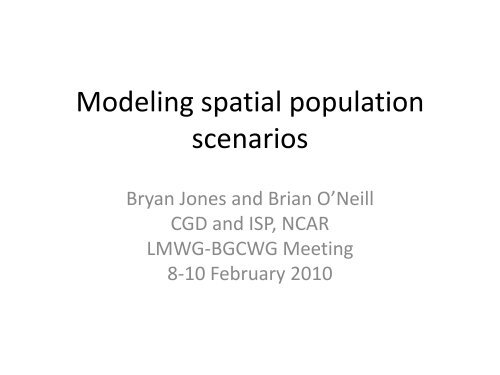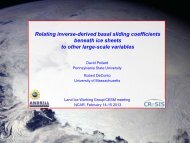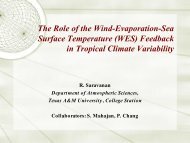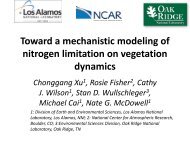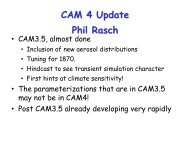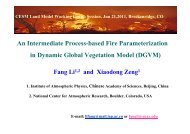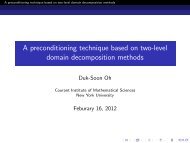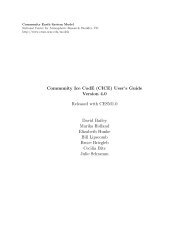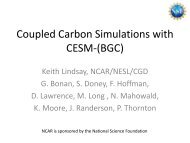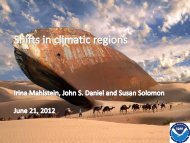Modeling spatial population scenarios
Modeling spatial population scenarios
Modeling spatial population scenarios
You also want an ePaper? Increase the reach of your titles
YUMPU automatically turns print PDFs into web optimized ePapers that Google loves.
<strong>Modeling</strong> <strong>spatial</strong> <strong>population</strong><br />
<strong>scenarios</strong><br />
Bryan Jones and Brian O’Neill<br />
CGD and ISP, NCAR<br />
LMWG-BGCWG Meeting<br />
8-10 February 2010
Introduction and Outline<br />
• The iPETS integrated assessment model<br />
• Land use and <strong>spatial</strong> <strong>population</strong><br />
• Toward a <strong>spatial</strong> scenario generator<br />
– Understand a leading methodology (IIASA)<br />
• Apply to hypothetical, 1-D <strong>population</strong> distribution<br />
– Test against historical observations<br />
– Explore modifications<br />
– Goals for 2010
iPETS: Global, regionally disaggregated IA Model<br />
(Integrated Population-Economy-Technology-Science Model)<br />
Population<br />
Households<br />
PET<br />
Terrestrial<br />
Ecosystems<br />
ISAM<br />
Supply of<br />
Land<br />
Labor, Land,<br />
Capital<br />
Food and other<br />
goods<br />
LU Emissions<br />
CO 2 and Climate<br />
Producers<br />
Energy<br />
Emissions<br />
Ocean, Sea ice,<br />
Atmosphere
iPETS: Global, regionally disaggregated IA Model<br />
(Integrated Population-Economy-Technology-Science Model)<br />
Demographic<br />
Module<br />
• Population<br />
• Urbanization<br />
• Households<br />
• Spatial Distribution<br />
Population<br />
Household<br />
s<br />
PET<br />
Terrestrial<br />
Ecosystems<br />
ISAM<br />
Supply of<br />
Land<br />
Labor, Land,<br />
Capital<br />
Food and other<br />
goods<br />
LU Emissions<br />
CO 2 and Climate<br />
Producers<br />
Energy<br />
Emissions<br />
Ocean, Sea ice,<br />
Atmosphere
IIASA Methodology<br />
1. Cells are classified as rural or urban.<br />
2. Population change regime (r) is defined for rural and urban areas.<br />
3. Potential is calculated for each cell according to:<br />
v<br />
i<br />
=<br />
m<br />
j,<br />
u<br />
2<br />
j= 1 Dij<br />
∑<br />
P<br />
n<br />
k , r<br />
2<br />
k = 1 Dik<br />
∑<br />
4. For each time step, additional <strong>population</strong> is allocated<br />
proportional to cell potential such that:<br />
P<br />
t+<br />
1<br />
i<br />
=<br />
P<br />
t<br />
i<br />
+ ( P<br />
t+<br />
1<br />
A<br />
+<br />
−<br />
P<br />
t<br />
A<br />
P<br />
)<br />
v<br />
t<br />
i<br />
J A<br />
∑ j=<br />
1<br />
• Calculation of potential for cell i does not include the <strong>population</strong> of cell i.<br />
• Rural/urban <strong>population</strong> gain/loss is allocated separately.<br />
• Cell potential used as a measure of attractiveness: geographic proximity to<br />
<strong>population</strong> is a proxy for all socio-economic characteristics that determine<br />
“attractiveness”.<br />
v<br />
t<br />
j
Application to Hypothetical Population Distribution<br />
Tested the model on a hypothetical 1-dimensional <strong>population</strong><br />
distribution to explore general trends in <strong>population</strong> allocation and the<br />
implications of changes in certain parameters.<br />
Findings<br />
• When <strong>population</strong> growth is positive, the model tends to move towards a<br />
uniform <strong>spatial</strong> allocation.<br />
• When <strong>population</strong> growth is negative, the model tends to move towards a<br />
concentrated <strong>spatial</strong> allocation.<br />
• Population growth generally occurs in areas that are currently defined as urban,<br />
or are immediately adjacent to existing urban areas.<br />
• The classification of a cell as urban/rural has a dramatic affect on the projected<br />
<strong>population</strong> in that cell, largely a result of exogenous urban/rural growth<br />
projections.
Test Against Historical Data<br />
Using the state of Iowa as the study region, the IIASA methodology is<br />
applied in an attempt to replicate historical data.<br />
• Areal units are counties (in place of grid cells).<br />
• Time period: 1950-2000<br />
Observed county <strong>population</strong> in 1950 serves as the initial distribution.<br />
• Observed decennial census data (1950-2000) are used to determine r.<br />
Total urban/rural <strong>population</strong> change are therefore fixed at the observed<br />
levels.<br />
• An attempt to replicate 2000 county-level <strong>population</strong> structure moving<br />
forward from 1950.<br />
• The model was run seven times using various methods to re-classify counties<br />
as urban or rural over time.<br />
The results in this presentation consider the <strong>population</strong> density threshold<br />
of 100 persons/mi² to classify/reclassify a county as urban or rural.
Results: Prediction Error
Historical Test: Findings and Implications<br />
• Population change is allocated too uniformly within the urban and rural regions.<br />
Population growth is under-estimated in some urban corridors.<br />
Population loss is under-estimated in the most remote rural counties.<br />
• Difficult for rural cells to reach the density threshold necessary to be reclassified.<br />
Due to low rate of rural growth.<br />
The model is likely to miss potential suburban growth that occurs in rural areas<br />
adjacent to urban centers.<br />
• The model does not allow for <strong>population</strong> growth/decline to occur simultaneously<br />
across cells in the same category.<br />
The model cannot account for <strong>population</strong> redistribution within rural areas, a<br />
common rural phenomena in which people congregate in larger regional<br />
centers.<br />
• Cells located nearer to the regional borders are subject to lower potentials,<br />
relative to cells located in the center of the region.<br />
Potential border or “coastal” effect in which growth occurring near regional<br />
borders (or on the coast) is under-predicted.
v<br />
i<br />
m P<br />
α<br />
P<br />
λ n P<br />
α<br />
P<br />
λ<br />
= ∑<br />
i j,<br />
u<br />
+ ∑<br />
i k , r<br />
D<br />
β<br />
D<br />
β<br />
j= 1 ij k = 1 ik<br />
⎛<br />
⎜<br />
⎜<br />
⎝<br />
Cell Potential Parameters<br />
α<br />
Parameter Description IIASA Value Test Range<br />
α<br />
λ β<br />
γ<br />
Weight of cell i’s <strong>population</strong>, higher values<br />
lead to more concentrated change. 0 0-2<br />
Weight of cell j’s <strong>population</strong>, higher<br />
values lead to more dispersed growth. 1 0-2<br />
Distance weight, higher values lead to<br />
more concentrated change. 2 1-3<br />
Either 1 (<strong>population</strong> gain), or -1<br />
(<strong>population</strong> loss). Allocates gain or loss<br />
with theoretical appropriateness.<br />
⎞<br />
⎟<br />
⎟<br />
⎠<br />
γ<br />
1 1,-1
∆ % Error<br />
< -20%<br />
-20% to -10%<br />
-10% to 0%<br />
0% to 10%<br />
> 10%<br />
Results: Change in Prediction Error<br />
γ r<br />
γ<br />
u<br />
= −1<br />
= 1<br />
α<br />
= 1
Rural with border effects<br />
Rural, no border effects<br />
and no urban influence<br />
Hypothetical Study Area<br />
Rural with urban influence<br />
Urban
0.05<br />
0.04<br />
0.04<br />
0.03<br />
0.03<br />
0.02<br />
0.02<br />
0.01<br />
0.01<br />
0.00<br />
Distribution of Population and Potential<br />
when varying the β parameter.<br />
0 10 20 30 40 50 60 70<br />
% Pop<br />
% Pot (2)<br />
% Pot (1)<br />
% Pot (3)
Next Steps<br />
• Parameterization of factors affecting potential calculation and allocation rule<br />
using hypothetical study area (allow tuning/calibrating model to data).<br />
• Alternative methods for re-classifying cells as urban/rural.<br />
• Allow aggregate growth rate (r) to vary within the urban/rural region as a<br />
function of density or distance.<br />
• Add a third broad <strong>population</strong> category; “suburban”.<br />
Future Plans<br />
• Developing a model that can produce plausible alternative <strong>spatial</strong> <strong>population</strong><br />
<strong>scenarios</strong> given assumptions concerning future aggregate demographic change.<br />
• Explore the link between <strong>spatial</strong> <strong>population</strong> <strong>scenarios</strong> and urban land cover.
Modifying the IIASA Methodology<br />
Two changes were applied to the IIASA methodology:<br />
1. Including the <strong>population</strong> of each cell i in the calculation of its own potential.<br />
2. Allocating <strong>population</strong> loss using the inverse of cell potential.<br />
Potentially:<br />
• Increasing the concentration of <strong>population</strong> growth by increasing the relative<br />
potential of already highly populated cells.<br />
Improving ability to capture rapid urban growth.<br />
• Increasing the concentration of rural growth in areas adjacent to urban areas.<br />
• Increasing the concentration of <strong>population</strong> loss in those cells with the lowest<br />
potential (usually the most remote cells).<br />
• Allowing for simultaneous growth/decline to take place within rural regions by<br />
concentrating growth in cells with the highest potential, and decline in those<br />
with the lowest.<br />
• Decreasing the impact of the border effect, particularly in areas of concentrated<br />
coastal development.
Methodological Changes: Findings and Implications<br />
• The adjustments did produce improvements in the right direction, however not<br />
at the level necessary to eliminate the issues that have been identified.<br />
• Urban <strong>population</strong> allocation is more concentrated.<br />
• Rural <strong>population</strong> growth is more concentrated in areas adjacent to urban<br />
centers, while <strong>population</strong> loss is more concentrated in remote areas.<br />
• The model projected both growth and decline within the rural region over the<br />
entire period.<br />
• However, <strong>population</strong> growth in rural cells was still too small to allow any of them<br />
to reach the density threshold necessary for reclassification.<br />
• The initial urban/rural classification (and rule for re-classification over time)<br />
appears to remain the largest factor affecting <strong>population</strong> change.
R Rural Cell<br />
U Urban Cell<br />
Cell i<br />
Rural cell k<br />
Urban cell j<br />
Not included<br />
Cell Potential: Examples<br />
A B B<br />
R R R R R R R R R R R R R R R<br />
R R R R R R R R R R R R R R R<br />
R R R R R R R R R R R R R R R<br />
R R R R R R R U U U R R R R R<br />
R R R R R R R R U U R R R R R<br />
R R R R R R R R U U R R R R R<br />
R R R R R R R R R R R R R R R<br />
R R R R R R R R R R R R R R R<br />
R R R R R R R R R R R R R R R<br />
R R R R R R R R R R R R R R R<br />
R R R R R R R R R R R R R R R<br />
R R R R R R R R U U U R R R R<br />
U R R R R R R R U U U R R R R<br />
U R R R R R R R R U R R R R R<br />
R R R R R R R R R R R R R R R<br />
R R R R R R R R R R R R R R R<br />
R R R R R R R R R R R R R R R<br />
R R R R R R R R R R R R R R R<br />
R R R R R R R U U U R R R R R<br />
R R R R R R R R U U R R R R R<br />
R R R R R R R R U U R R R R R<br />
R R R R R R R R R R R R R R R<br />
R R R R R R R R R R R R R R R<br />
R R R R R R R R R R R R R R R<br />
R R R R R R R R R R R R R R R<br />
R R R R R R R R R R R R R R R<br />
R R R R R R R R U U U R R R R<br />
U R R R R R R R U U U R R R R<br />
U R R R R R R R R U R R R R R<br />
R R R R R R R R R R R R R R R<br />
R R R R R R R R R R R R R R R<br />
R R R R R R R R R R R R R R R<br />
R R R R R R R R R R R R R R R<br />
R R R R R R R U U U R R R R R<br />
R R R R R R R R U U R R R R R<br />
R R R R R R R R U U R R R R R<br />
R R R R R R R R R R R R R R R<br />
R R R R R R R R R R R R R R R<br />
R R R R R R R R R R R R R R R<br />
R R R R R R R R R R R R R R R<br />
R R R R R R R R R R R R R R R<br />
R R R R R R R R U U U R R R R<br />
U R R R R R R R U U U R R R R<br />
U R R R R R R R R U R R R R R<br />
R R R R R R R R R R R R R R R<br />
Spatial/Theoretical Implications<br />
The classification of a cell as rural/urban has a large impact on the<br />
calculation of potential for all cells within the urban window.<br />
• Inclusion in window<br />
• Size of <strong>population</strong><br />
The classification of a cell as rural/urban has a no impact on the<br />
calculation of potential for cell i.<br />
Possible border/coastal effects.<br />
• The interior urban area (B) has a larger rural window than the border urban<br />
area (C).<br />
Proximity to <strong>population</strong> as an indicator of future growth/decline.<br />
Suggests that future urban development will take place almost exclusively<br />
in areas that are either currently urban, or are adjacent to existing urban<br />
areas.
Results: Assuming constant r = 5%<br />
Cell Pop(0) Pop(50) ∆ Pop % ∆ Pop ∆ %Pop<br />
A 13 10,287 10,274 79032% 0.88%<br />
B 53 15,762 15,709 29640% 1.32%<br />
C 187 22,018 21,831 11674% 1.73%<br />
D 564 30,395 29,831 5289% 2.09%<br />
E 1,455 41,839 40,384 2776% 2.19%<br />
F 3,205 56,805 53,600 1672% 1.75%<br />
G 6,027 74,711 68,684 1140% 0.49%<br />
H 9,680 93,433 83,753 865% -1.53%<br />
I 13,273 109,410 96,137 724% -3.73%<br />
J 15,543 118,709 103,166 664% -5.19%<br />
K 15,543 118,709 103,166 664% -5.19%<br />
L 13,273 109,410 96,137 724% -3.73%<br />
M 9,680 93,433 83,753 865% -1.53%<br />
N 6,027 74,711 68,684 1140% 0.49%<br />
O 3,205 56,805 53,600 1672% 1.75%<br />
P 1,455 41,839 40,384 2776% 2.19%<br />
Q 564 30,395 29,831 5289% 2.09%<br />
R 187 22,018 21,831 11674% 1.73%<br />
S 53 15,762 15,709 29640% 1.32%<br />
T 13 10,287 10,274 79032% 0.88%<br />
Notes<br />
The trends are the same as those we saw previously, just exaggerated<br />
due to the larger rate of growth.
Results: Assuming constant r = -5%<br />
Cell Pop(0) Pop(50) ∆ Pop % ∆ Pop ∆ %Pop<br />
A 13 0 -13 -100% -0.01%<br />
B 53 0 -53 -100% -0.05%<br />
C 187 0 -187 -100% -0.19%<br />
D 564 0 -564 -100% -0.56%<br />
E 1,455 0 -1,455 -100% -1.46%<br />
F 3,205 0 -3,205 -100% -3.21%<br />
G 6,027 0 -6,027 -100% -6.03%<br />
H 9,680 494 -9,186 -95% -3.26%<br />
I 13,273 1,363 -11,910 -90% 4.44%<br />
J 15,543 1,990 -13,553 -87% 10.32%<br />
K 15,543 1,990 -13,553 -87% 10.32%<br />
L 13,273 1,363 -11,910 -90% 4.44%<br />
M 9,680 494 -9,186 -95% -3.26%<br />
N 6,027 0 -6,027 -100% -6.03%<br />
O 3,205 0 -3,205 -100% -3.21%<br />
P 1,455 0 -1,455 -100% -1.46%<br />
Q 564 0 -564 -100% -0.56%<br />
R 187 0 -187 -100% -0.19%<br />
S 53 0 -53 -100% -0.05%<br />
T 13 0 -13 -100% -0.01%<br />
Notes<br />
The lightly populated exterior cells quickly empty out.<br />
Population becomes concentrated in the interior cells.<br />
Potential remains greater in the interior cells, so these cells suffer more<br />
absolute <strong>population</strong> loss at each time step.


